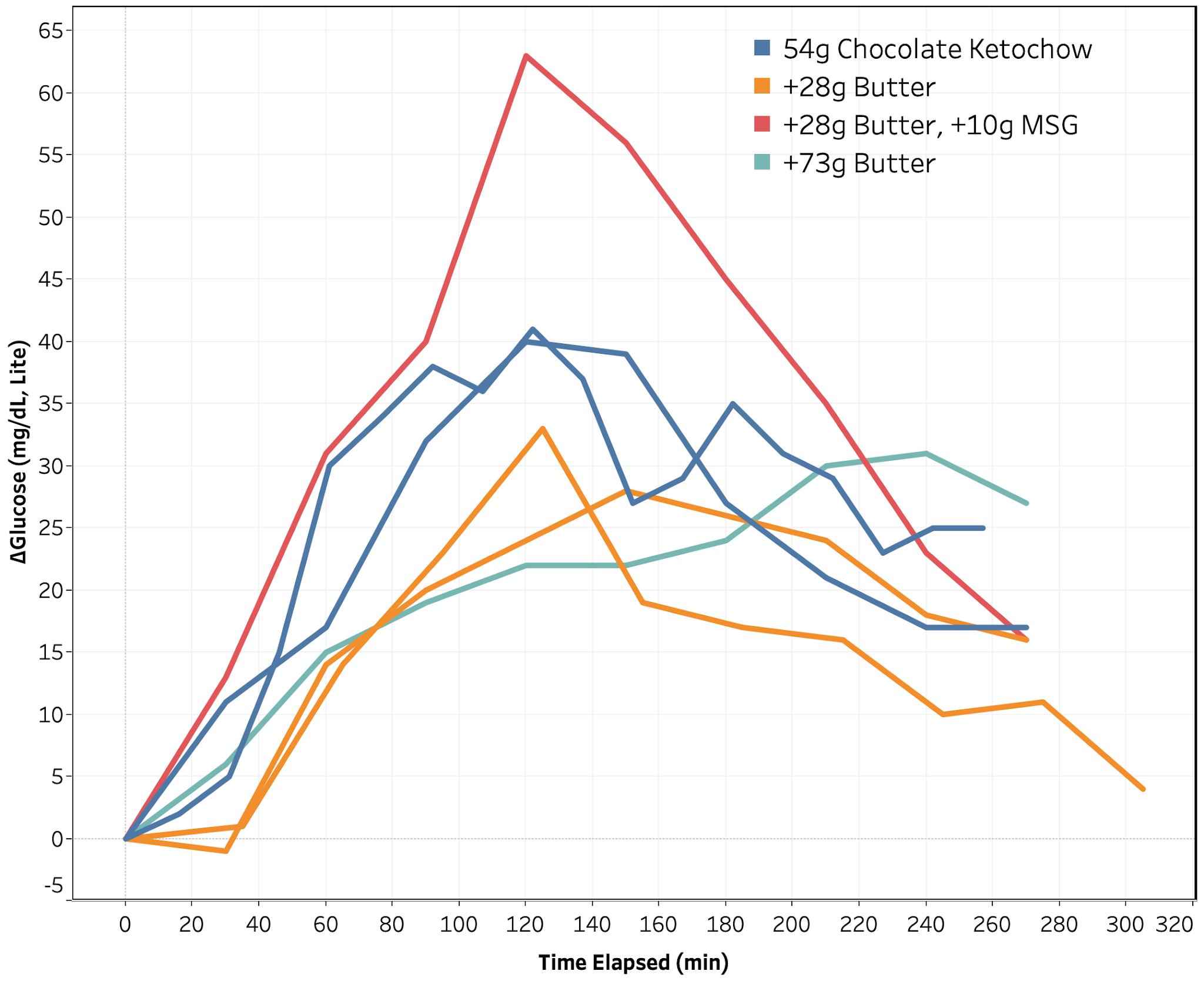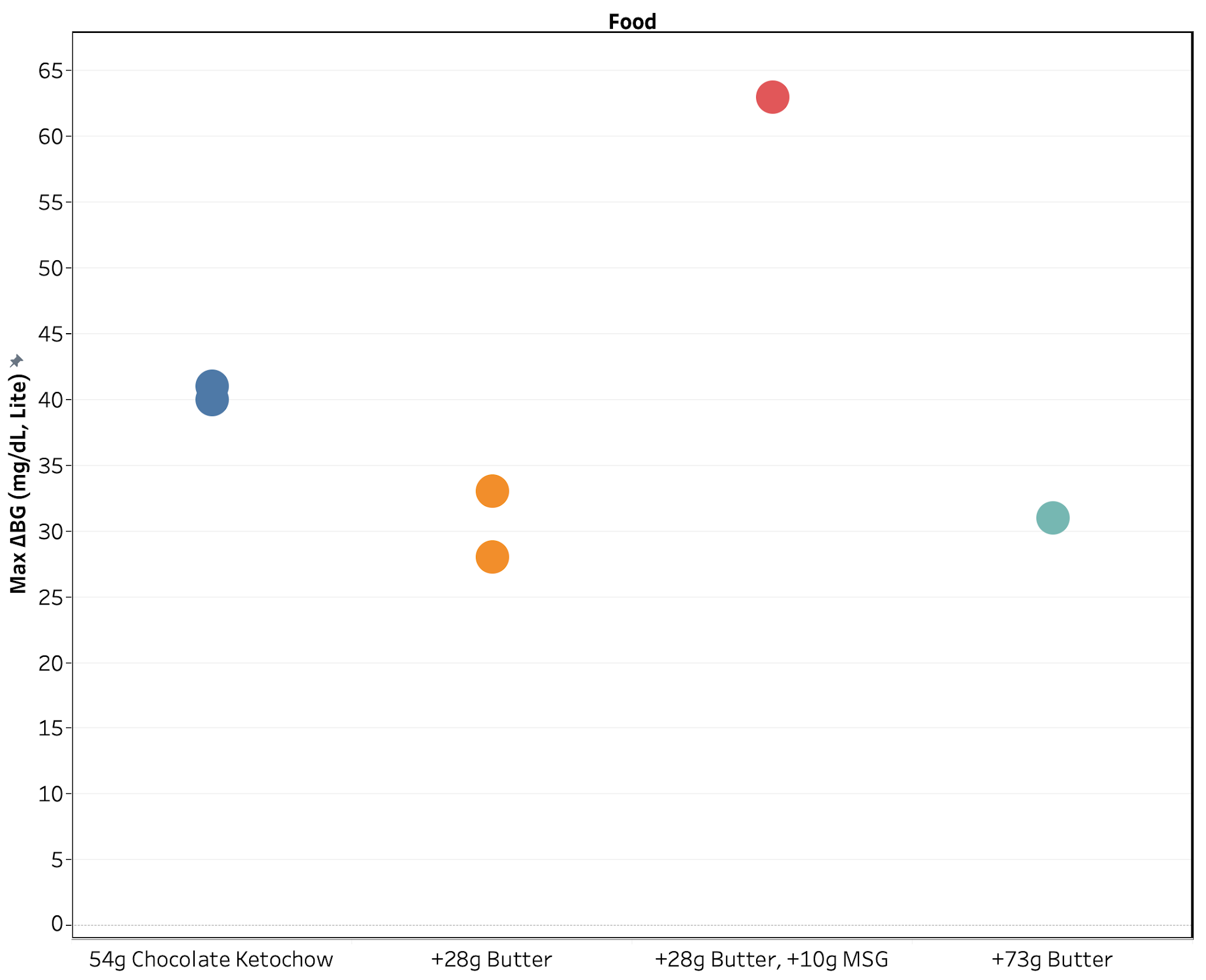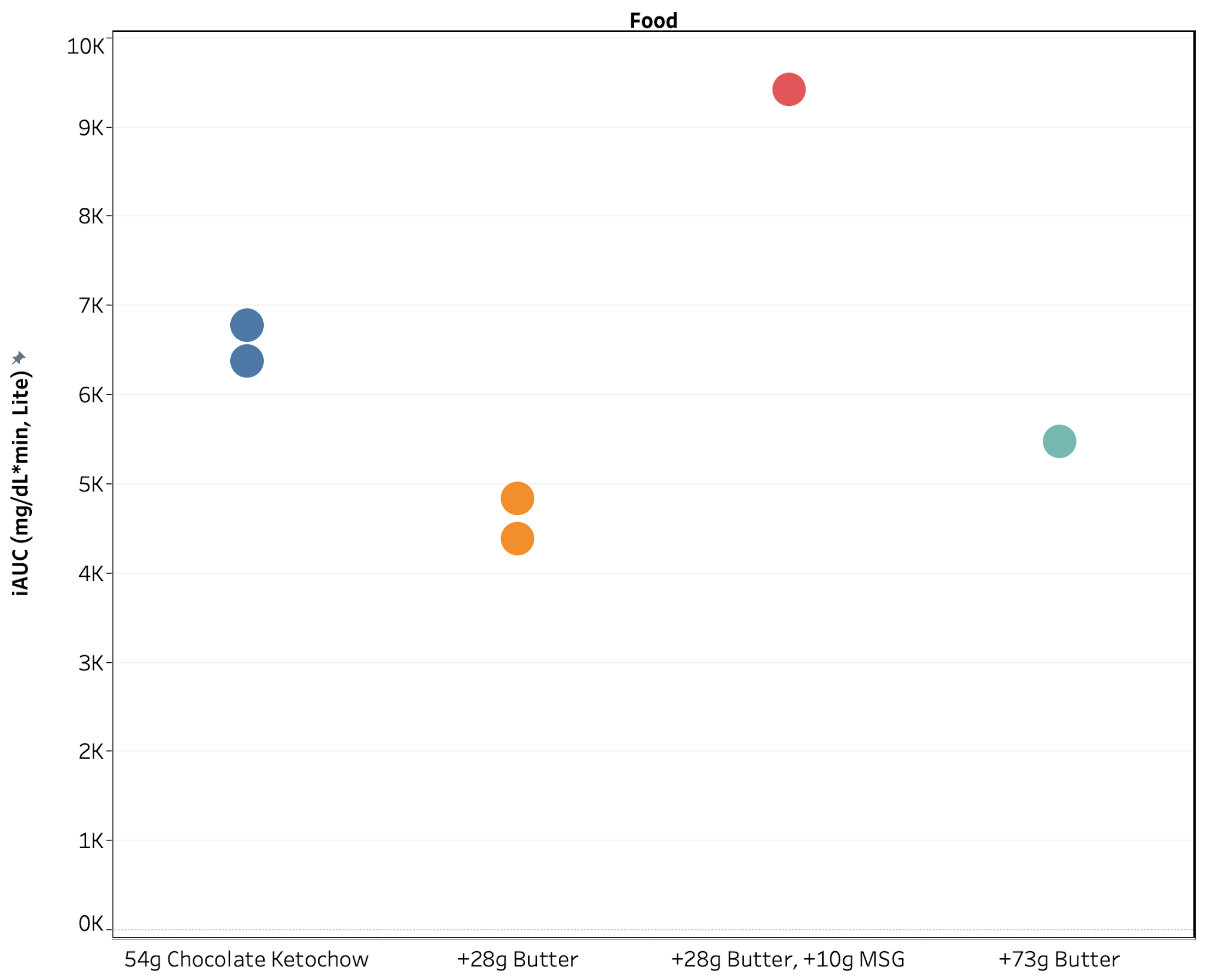Get new posts by email or rss feed
This post is an update on my experiments measuring the effect of dietary supplements and low-carb foods on blood sugar. This is going to be an on-going exploration. Rather than wait for complete sets of data (which would take a long time), I’m going to post each weeks worth of data as I collect it in the hopes of soliciting feedback to guide later experiments.
As always, if you have any comments, suggestions, ideas for new experiments, or want to participate, please let me know in the comments or send a PM via the contact form or to quantifieddiabetes_at_gmail.com.
Planned Experiments
- Baseline:
- Glucose re-test
- Fasting re-test
- Low-carb foods:
- Ketochow: This post
- Carbquick
- Eggs
- Supplements:
- Vinegar
- MSG: Started 10/2
Preliminary Results: Ketochow, Butter, & MSG



Ingredient Background
Ketochow is a low-carb meal-replacement that is designed to have all the macro- and micro-nutrients you need to stay healthy. I have it for breakfast and lunch most days. It’s extremely convenient and surprisingly good. I prepare 16 meals at a time and keep them in the fridge. When it’s time for a meal, I just add hot water, mix, and wait for my insulin to kick in; about 1 min. total prep. time (all-in). It also comes in 18 different flavors, so I can rotate through the ones I like and not get bored. I’ve been using Ketochow for years, so I’ve got my insulin dose pretty well tuned for it. However, following a Reddit post by Chris Bair, the owner of Ketochow on its Glycemic Index, I decided to do a detailed test of its impact on my blood sugar.
Butter is a solid fat source. I use it with my ketochow meals as it doesn’t mix with the powder until melted, giving the mixture excellent shelf-life.
Monosodium glutamate (MSG), is the sodium salt of glutamic acid (an amino acid). It’s primarily used in cooking as a umami flavor enhancer. It’s also been reported to reduce blood glucose when ingested along with a meal (references here). Most of the reported studies were done with high carbohydrate meals and on non-diabetics, so I was interested to test its effect with low carbohydrate meals for myself.
Procedure
I consumed 1.1 servings of the chocolate ketochow (54g, my normal amount) and the specified quantities of butter and MSG mixed with hot water to a total volume of ~12 oz. I then monitored my blood sugar every 30 min for ~270 min.
Results
As shown in Figure 1, plain Ketochow shows a slow rise of ~40 mg/dL over ~2h. As discussed previously, this is similar to whey protein (the primary caloric ingredient in Ketochow is an 80:20 mix of casein & whey protein) and pretty much what you’d expect from the nutrition label and the amount of insulin I use to cover the meal.
Much more interesting is the impact of butter and MSG. The addition of butter significantly slowed the rise in blood glucose and gave an ~25% reduction in peak blood glucose and 30% reduction in iAuC. Interestingly, increasing the amount of butter from 28 to 73g did not increase the effect, though that was only a single experiment and I need to repeat it to confirm.
For MSG, in contrast to the reported literature, it significantly increased the rate of rise, peak, and iAuC of my blood glucose. This was a single experiment and I haven’t yet done the proper controls (e.g. MSG by itself), but the magnitude of the effect was much larger than I would expect from the amount of amino acid consumed, suggesting it is real. Going forward, I’m going to test MSG by itself, smaller quantities, and also combined with glucose instead of protein fat (more similar to the literature.
Interim Thoughts and Next Steps
From this preliminary data, it looks like there are meaningful effects of combining macronutrients as well as supplements. Given that, I’m going to stick with this line of experiments. I also like this approach of posting interim data as I collect it, then writing up a more detailed report & analysis once there’s enough data to merit it.
As always, please let me know if you have any thoughts or suggestions.
– QD
Hi QD!
Here you reveal one of the most complicated phenomena of diabetes nutrition. Proper mixing of carbs and fat!. Both are indispensable (I could argue the carbs, never the fat), and at certain points, varying the quantity of fat does not alter its effect. Problem is when you get this “buffer-like” effect derived from slowed gastric emptying, with a high carb load (summer with the insulin resistance induction), that’s problematic, and there’s not a formula to quantify how a T1D could do a proper insulin correction on top of that equation.
Keep doing your good work!
Fellow MD and T1d,
Regarding the quantity of fat not altering its effect. Do you know of any literature that looked at that? I’ve seen it in my own data and would like to understand it better.
BTW, I’m not an MD, though I do have my Ph. D. :).
You mention you prep 16 shakes at a time then just add hot water and mix, and that the butter “doesn’t mix with the powder until melted, giving the mixture excellent shelf-life”.
Could you describe in more detail? Are the prepped shakes just KetoChow powder and a lump of butter in a jar sitting in the fridge?
If you add hot water, mix, and consume immediately how is the flavor and texture? Do you enjoy them warm?
I’ve been mixing up batches of 4-8 and then leaving them in the fridge, but if I understand your method it sounds simpler, less likely to spoil, and would allow switching up flavors.
Yep, the prepped shakes are just the Ketochow powder and butter in a blender bottle (I use the one from Contigo) sitting in my fridge. I started doing this when I was traveling for work and needed a way to transport the Ketochow pre-prepared, but without a liquid. I make 16 at a time using 4 different flavors. I haven’t rigorously tested the shelf life, but I’ve kept them in the fridge >20 days with no issue and given that both butter and the ketochow powder have multi-month shelf life when refrigerated, I don’t see any reason it would spoil.
Preparation is exactly as you described. Add hot water, mix, and consume. I find that I need to mix it up, wait a few minutes, then mix again to give the powder time to hydrate and break up all the clumps, but I’ve had it right away on a few occasions and it’s still fine.
The flavor is slightly different than with heavy whipping cream. I say somewhat more intense. I prefer it, but YMMV. Texture is tunable based on the amount of water you add. I prefer my shakes thick and fill the water up to the 12 oz line on the bottle, much less than the 20 oz recommended by Ketochow’s instructions.
Excellent information! Thanks so much for the detailed write-up. I’ve been eating this stuff on and off for years but that sounds like a much more convenient preparation method than any I have used. Gonna give it a try today.
Hope it works for you!